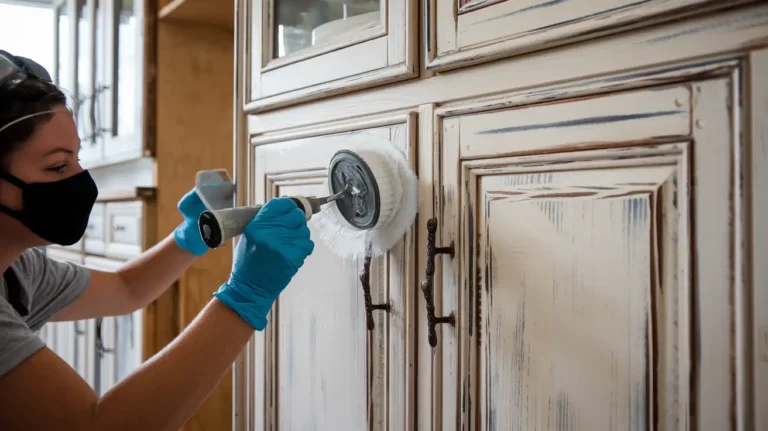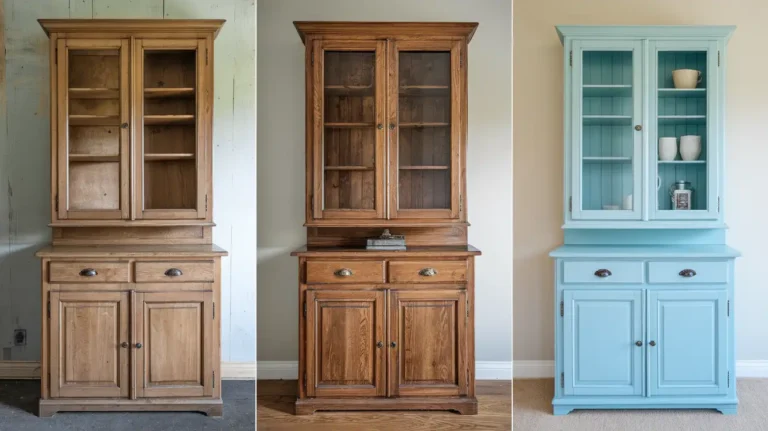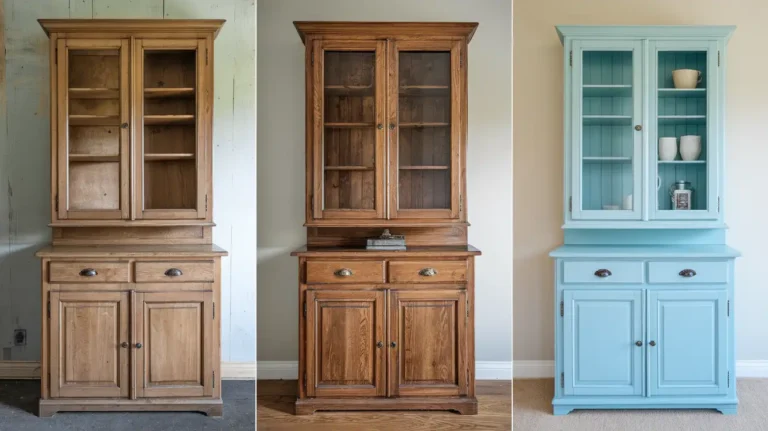Thinking about updating your kitchen cabinets but stuck between refinishing and painting? The cabinet refinishing vs painting debate confuses many homeowners. Here’s the straight answer: refinishing strips of old finish to reveal natural wood grain with new stains, while painting applies color over existing surfaces. Your choice depends on your cabinet material, budget, and desired look. We’ve transformed over 500 San Diego kitchens, and this guide shares exactly what works.
Both methods can dramatically update your space without full replacement. You’ll save thousands compared to new cabinets. This article breaks down costs, processes, and real results from our San Diego projects so you can decide with confidence.
Table of Contents
What Is Cabinet Refinishing?
Cabinet refinishing restores wood cabinets to their original beauty. The process removes old varnish, stain, or paint down to bare wood. Then new stains and protective coating bring the natural grain back to life.
This method only works on solid wood cabinets. You can’t refinish laminate, thermofoil, or MDF materials. The goal is to enhance what’s already there, not hide it.
Many San Diego homeowners choose refinishing for craftsman-style homes or mid-century properties. These homes often have quality wood worth preserving. The natural wood aesthetic fits perfectly with Southern California’s organic design trends.
Refinishing takes more time and skill than painting. But the results last 15-20 years with proper care. You get a deep, rich finish that painted cabinets can’t match.
Cabinet Refinishing Process

Professional refinishing follows specific steps for quality results:
Step 1: Removal and Setup
We remove all cabinet doors and drawer fronts. Hardware comes off next. Everything gets labeled for easy reinstallation. The workspace needs proper ventilation due to stripping chemicals.
Step 2: Stripping Old Finish
Chemical strippers or heavy sanding removes existing coats. This reveals the raw wood underneath. In San Diego’s coastal areas, we often find salt air damage that needs addressing at this stage.
Step 3: Repair Work
Wood filler fixes dents, scratches, and dings. We sand these repairs smoothly. This step separates professional work from DIY attempts. Quality repair work is invisible in the final result.
Step 4: Progressive Sanding
Multiple rounds of sanding create the perfect surface. We start with coarse grit and work to fine. The wood must feel completely smooth before staining. Any rough spots will show in the final finish.
Step 5: Stain Application
New stain soaks into the wood grain. We apply it with fine brushes and clean clothes. The stain sits for several minutes before wiping excess. Multiple coats achieve deeper color if desired.
Step 6: Protective Topcoat
Three to four coats of polyurethane or lacquer seal the wood. Each coat gets light sanding between applications. This creates a durable, glass-like finish. San Diego’s mild climate allows year-round application without humidity issues.
Cabinet Refinishing Options
Your stain choices range from light to dark:
- Light Stains: Natural, maple, honey tones work well in smaller kitchens. They reflect light and create open, airy feels. Popular in North Park and South Park homes.
- Medium Stains: Oak, walnut, and cherry tones offer warmth without going too dark. These match most San Diego home styles from coastal to suburban.
- Dark Stains: Espresso, mahogany, and ebony create dramatic contrast. They work best in kitchens with ample natural light. Common in La Jolla and Del Mar luxury homes.
- Weathered or Distressed: These finishes add character to farmhouse or rustic designs. The technique requires additional steps but creates unique results.
Pros and Cons of Cabinet Refinishing
Advantages:
Refinishing preserves natural wood character that increases home value. Real estate agents in San Diego confirm buyers pay a premium for quality wood finishes. The depth and richness can’t be replicated with paint.
Durability exceeds painted surfaces. A professional refinish lasts 15-20 years in normal use. High traffic kitchens still see 12-15 years before needing to be refreshed. The multiple topcoat layers resist moisture, heat, and daily wear.
You’re making an eco-friendly choice by reusing existing materials. No cabinets go to landfills. This aligns with California’s environmental values and often matters to conscious buyers.
Refinishing offers customization within wood tones. You can go lighter, darker, or change undertones completely. The natural grain pattern stays unique to your cabinets.
Limitations:
The cost runs higher than painting. Expect to invest $3,500-$8,000 for average San Diego kitchens. The labor-intensive process and specialized materials drive prices up. Small kitchens start around $2,500 while large custom layouts reach $12,000.
Time commitment is significant. Professional jobs take 5-7 days minimum. Larger kitchens or extensive damage extends this to two weeks. Your kitchen stays disrupted throughout.
Only solid wood cabinets qualify. If you have laminate, MDF, or previously painted cabinets with unknown wood underneath, refinishing won’t work. About 40% of San Diego homes built after 1990 have non-refinishable cabinets.
The stripping process creates serious dust and fumes. Even with proper ventilation, some smell lingers. Families with respiratory sensitivities should plan to stay elsewhere during stripping days.
What Is Cabinet Painting?

Cabinet painting applies fresh coats of paint over existing cabinet surfaces. This completely changes color while hiding the original finish. You can paint wood, laminate, MDF, or previously painted cabinets.
Painting offers the biggest aesthetic transformation. A dated oak kitchen becomes bright white modern. Dark cabinets turn into light, airy spaces. The options are truly unlimited.
White kitchen cabinets remain San Diego’s most requested color. But we’re seeing increased interest in sage green, navy blue, and warm gray tones. These colors align with 2025 design trends favoring earthy, natural palettes.
Professional cabinet painting delivers factory-like finishes. The difference between DIY and pro work is dramatic. Proper spray equipment and technique creates smooth, even coats without brush marks.
Cabinet Painting Process
Here’s how professionals transform cabinets with paint:
Preparation Phase
Remove all doors and drawer fronts from frames. Take off cabinet hardware and label everything. Deep clean surfaces to remove grease, cooking oils, and grime. San Diego kitchens near the coast need extra degreasing due to salt air.
Surface Prep
Light sanding creates texture for primer adhesion. We use 220-grit paper to scuff surfaces without removing material. Fill any holes, dents, or damage with wood filler. Sand these repairs completely smooth.
Priming
High-quality bonding primer goes on first. This seals wood, blocks stains, and creates perfect paint adhesion. Most projects need two primer coats for complete coverage. Primer prevents old stains from bleeding through topcoats.
Paint Application
Professional sprayers apply thin, even coats of paint. We use cabinet-specific acrylic-alkyd hybrids or lacquer. These paints level smoothly and cure harder than standard wall paint. Three coats typically achieve full coverage and depth.
Curing and Reassembly
Painted surfaces need 48-72 hours to cure before handling. Rushing this step causes problems later. After curing, we reinstall doors and drawer fronts with new or existing hardware.
Pros and Cons of Cabinet Painting
Benefits:
Painting costs less than refinishing or new cabinets. Average San Diego kitchens run $2,000-$5,000 professionally painted. This makes updating accessible to more homeowners. DIY attempts cost even less but rarely achieve professional results.
Color options are unlimited. Match any décor style from traditional to ultra-modern. Change colors easily in future repaints. This flexibility appeals to homeowners who update styles regularly.
The process moves faster than refinishing. Most professional painting jobs complete in 3-5 days. Small kitchens sometimes finish in two days. Less disruption means faster return to normal life.
Painting hides minor imperfections in cabinet surfaces. Small scratches, dings, or inconsistencies disappear under paint. This works great for older cabinets with character marks.
You can update cabinets regardless of material. Laminate, MDF, and previously painted surfaces all accept new paint. This opens options for homes with non-wood cabinets.
Drawbacks:
Painted surfaces show wear faster than refinished wood. Chips and scratches reveal underlying color. High-traffic areas near handles need touch-ups within 5-10 years. Professional work lasts longer than DIY attempts.
Paint covers natural wood grain completely. If you love wood characters, painting removes this forever. Some San Diego buyers specifically seek real wood finishes.
Surface preparation takes serious time and effort. Skipping proper prep leads to peeling, chipping, and poor adhesion. This prep work is why painting cabinets costs more than many expect.
Multiple coats are required for durability and appearance. Two coats rarely suffice for professional results. Each coat adds time and material costs.
What About Cabinet Refacing?
To truly understand Cabinet Refinishing vs Painting, you must also consider the third option: Cabinet Refacing. This is often the best choice when your cabinets are structurally fine, but you want a total change in cabinet door style.
Refacing is not painting, and it is not restoration. Refacing involves replacing the aesthetic parts of the cabinets while keeping the existing structure.
Cabinet Refacing Process
The refacing process focuses on material replacement rather than a chemical finish.
- Removal: The old cabinet doors and drawer fronts are removed and discarded.
- Box Coverage: A new, durable skin, or veneer, is applied to the exterior of the existing kitchen cabinet boxes. This veneer is often 3D laminate or real wood veneer.
- New Components: Brand new, custom-sized doors and drawer fronts are installed. This allows you to completely change the style, such as switching from an old-fashioned raised panel to a modern Shaker design.
- Hardware Installation: New cabinet hardware and hinges are installed, completing the total transformation.
Pros and Cons of Cabinet Refacing
Pros | Cons |
Total Style Change: Allows for a complete change in door style that painting cannot offer. | Higher Cost Than Painting: Refacing cabinets is generally more expensive than a paint job. |
Fast Project Time: Installation is relatively quick with minimal disruption to your daily life. | No Structural Changes: You are stuck with the current layout and interior drawer configurations. |
Excellent Durability: New doors and laminates are factory-finished for long-term wear. | Involves replacing materials, which may feel less eco-friendly than restoration. |
Refinishing vs. Painting vs. Refacing: What's the Difference?

Choosing the right method depends on three factors: your current material, your budget, and your aesthetic goals.
Factor | Cabinet Painting | Cabinet Refinishing | Cabinet Refacing |
Aesthetic Goal | Uniform color change. | Restore or enhance natural wood grain. | Change door style entirely. |
Ideal Material | Wood cabinets, MDF, or laminate in any color. | Solid wood only (maple, oak, cherry, etc.). | Structurally sound boxes; any existing exterior material. |
Long-Term Durability | High quality, but depends heavily on preparation. May require future touch-ups. | Superior scratch and chemical resistance. Longevity is excellent. | Excellent, as new components are factory-finished. |
Budget ($$$) | $$ (Moderate) | $$$ (Premium) | $$$ (Premium) |
Resale Value | High, provided the work is professional and the color is neutral. | Highest, as it preserves and showcases solid wood quality. | High, as the kitchen looks brand new and updated. |
Real San Diego Project Examples
Case Study 1: Scripps Ranch Ranch Home
Original oak cabinets from 1985 looked dated. Homeowners wanted a lighter, modern feel. We refinished with natural maple stains. Cost: $4,200. Results lasted 18+ years before they moved.
Case Study 2: Pacific Beach Condo
Laminate cabinets couldn’t be refinished. Professional painting in white transformed the space. Cost: $2,800. Buyers loved the updated look at sale three years later.
Case Study 3: Mission Hills Craftsman
Original 1920s wood cabinets had been painted poorly. We stripped it to bare wood and refinished it with a rich walnut stain. Cost: $6,800. Preserved historical character while updating function.
Decision Framework
Ask yourself these questions:
- What material are my cabinets? (Check inside boxes)
- What’s my realistic budget including contingencies?
- How long can I handle kitchen disruption?
- Do I want to enhance or completely change appearance?
- How long do I plan to stay in this home?
Your answers reveal the best choice. No single option suits everyone.
Conclusion
The cabinet refinishing vs painting decision comes down to your specific situation. Refinishing preserves natural wood beauty with superior durability but costs more. Painting offers unlimited color options and lower costs but requires more frequent updates.
San Diego’s climate and diverse housing stock add unique considerations. Coastal homes need marine-grade finishes. Mid-century properties often have quality wood worth refinishing. Modern construction may have painted or laminate cabinets.
Both options dramatically improve your kitchen at a fraction of replacement cost. At San Diego Home Remodeling, we’ve guided hundreds of homeowners through this decision. Our painting services in San Diego deliver professional results that last. We also offer comprehensive kitchen remodeling services in San Diego when you’re ready for bigger changes.
The right choice enhances your daily life and home value. Take time to assess your cabinets, budget, and goals. Quality work requires investment, but the results transform your most-used space.
FAQs
How much does cabinet refinishing cost in San Diego?
Professional refinishing runs $3,500-$8,000 for average kitchens. Small spaces start around $2,500. Large custom kitchens reach $12,000. Costs depend on cabinet quantity, wood condition, and finish complexity.
Can you paint over refinished cabinets?
Yes, but proper preparation is essential. The glossy topcoat must be thoroughly sanded for paint adhesion. Most homeowners refinish again rather than paint since the wood is already exposed.
How long does cabinet painting last?
Professional cabinet painting lasts 10-12 years with normal use. High-quality paint and proper application extend lifespan. DIY jobs typically need refreshing in 3-7 years.
Is refinishing kitchen cabinets worth it?
Refinishing is worth the investment for solid wood cabinets in good condition. You preserve natural beauty while saving 60-70% compared to replacement. The 15-20 year lifespan provides excellent value.
What’s the difference between refacing and refinishing?
Refacing involves replacing doors and applying veneer to cabinet boxes. Refinishing strips and retains existing wood surfaces. Refacing costs more but allows style changes. Refinishing preserves original character.
Can laminate cabinets be refinished?
No, laminate cabinets can’t be refinished because there’s no real wood to expose. However, they can be painted successfully with proper primers and cabinet-specific paint formulas.
How long before I can use my kitchen after painting?
Painted cabinets need 48-72 hours curing time before normal use. Light use is possible sooner, but avoid heavy items or aggressive cleaning. Full cure takes 30 days.
Do painted cabinets chip easily?
Professional painted cabinets resist chipping when properly prepped and finished. Cheap paint or skipped prep steps lead to chipping. High-traffic areas show wear first regardless of quality.








